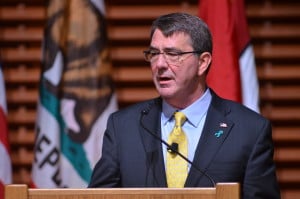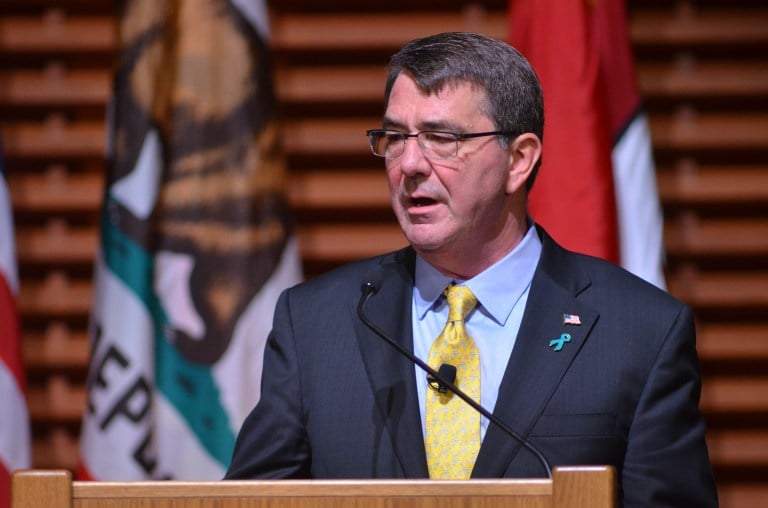
Defense Secretary Ashton Carter announced the Pentagon’s new innovation initiatives and cybersecurity strategy at CEMEX Auditorium today. Initiatives included building Cyber Mission Forces, enhancing security of Department of Defense (DoD) information, network and data and improving resiliency in the face of potential cyber attacks.
A theoretical physicist by training, Carter was named Defense Secretary by President Barack Obama last year when he was serving as a visiting scholar at Stanford’s Center for International Security and Cooperation (CISAC), the Freeman Spogli Institute and the Hoover Institution.
“We had hoped to have him for an entire academic year,” said President John Hennessy in his introductory remarks at the lecture.
In the lecture, titled “Rewiring the Pentagon: Charting a New Path on Innovation and Cybersecurity,” Carter also urged further cooperation between the DoD and the Silicon Valley in mitigating “the risk that comes with such technology while simultaneously unleashing its promise and potential.”
Carter emphasized that the Pentagon and the technology sector not only share many core values, including upholding a free and open Internet and protecting intellectual property, but also face the same threats of growing cyberterrorism, such as the recent North Korean attack on Sony’s networks.
“History shows us that we’ve succeeded in finding solutions to these kinds of tough questions when our commercial, civil and government sectors worked together as partners,” Carter said. “Today, we must and can do the same.”
For Carter, the key in bridging the gap and forming a partnership between the Pentagon and Silicon Valley lies in two areas: “innovation broadly and cybersecurity particularly.” In the talk, he detailed the initiatives that the DoD will be taking to strengthen such collaboration.
In terms of innovation, the DoD is establishing an in-department branch of the U.S. Digital Service, a program launched by the White House last August after healthcare.gov broke down. The branch will facilitate the creation of effective solutions for IT-related issues.
In addition, a DoD “point of partnership” will be initiated here in Silicon Valley. Defense Innovation Unit X-X — standing for Experimental — consisting of both active-duty and civilian personnel, is aimed at building relationships with Silicon Valley and looking for potential technological breakthroughs.
The Department will also extend the Secretary of Defense Corporate Fellows, a program that sends 15 officers to commercial enterprises for operational training each year. Concerned that DoD officers do not “effectively harness what they’ve learned when they come back,” Carter said that such an extension would allow officers to better contribute their organizational expertise to the military.
Carter also spoke about embracing openness and fostering cooperation in regards to cybersecurity. The new cybersecurity strategy centers upon three objectives: safeguarding DoD networks, systems and information, defending America’s national interests against serious cyber attacks and integrating cyber capabilities in undergirding current and future military operations. Details of the strategy are available on the DoD website.
“This approach reflects two goals,” Carter said. “First, keeping the Internet open, secure and prosperous. And second, ensuring that we continue to respect — and protect — the freedoms of expression, association and privacy that reflect who we are as a nation.”
Contact Qitong Cao at qitong ‘at’ stanford.edu.
